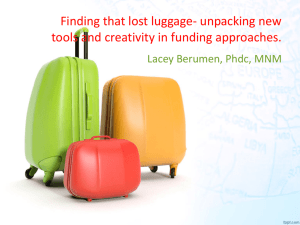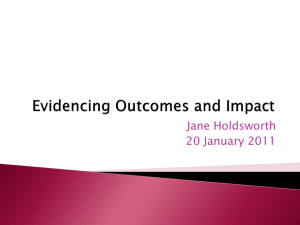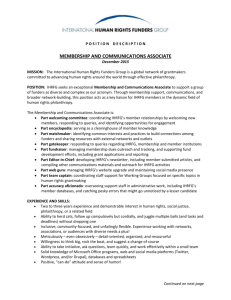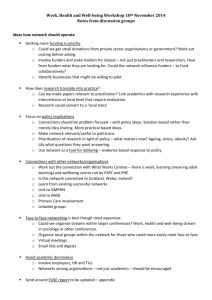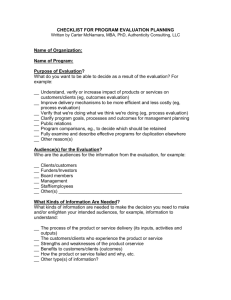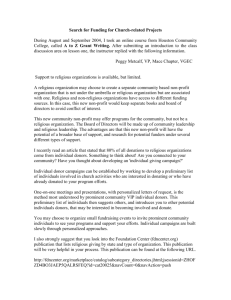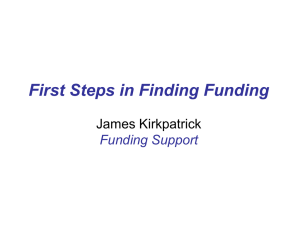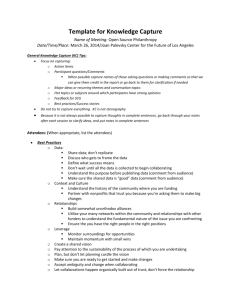Foundation Investments To Advance Smart Growth In California,
advertisement
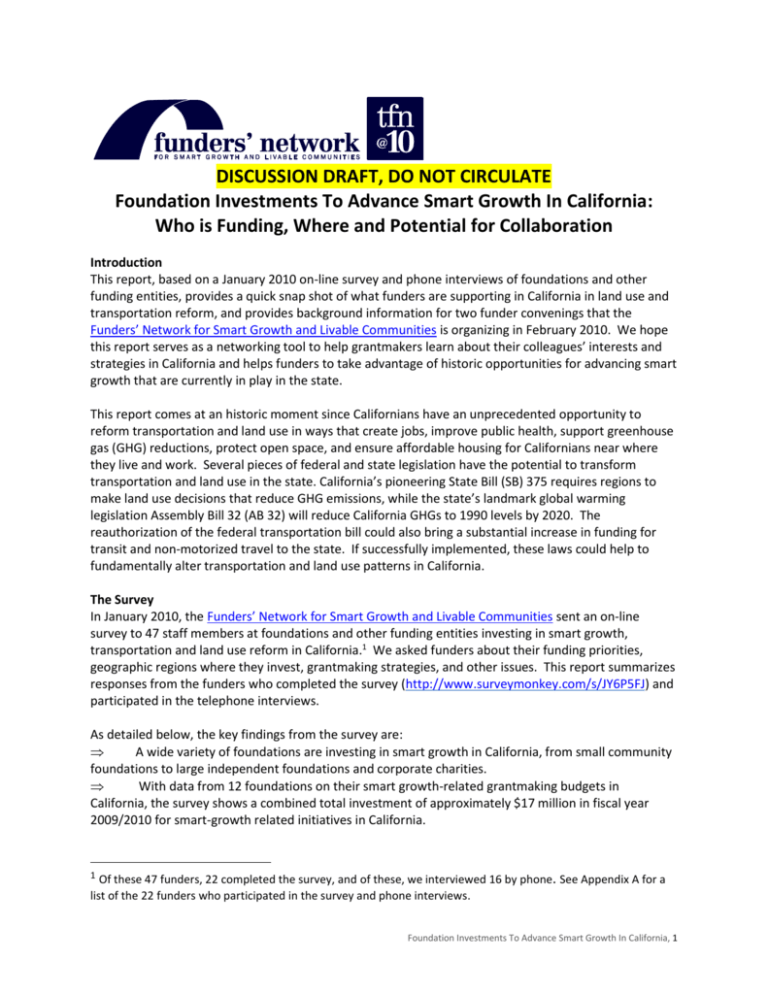
DISCUSSION DRAFT, DO NOT CIRCULATE Foundation Investments To Advance Smart Growth In California: Who is Funding, Where and Potential for Collaboration Introduction This report, based on a January 2010 on-line survey and phone interviews of foundations and other funding entities, provides a quick snap shot of what funders are supporting in California in land use and transportation reform, and provides background information for two funder convenings that the Funders’ Network for Smart Growth and Livable Communities is organizing in February 2010. We hope this report serves as a networking tool to help grantmakers learn about their colleagues’ interests and strategies in California and helps funders to take advantage of historic opportunities for advancing smart growth that are currently in play in the state. This report comes at an historic moment since Californians have an unprecedented opportunity to reform transportation and land use in ways that create jobs, improve public health, support greenhouse gas (GHG) reductions, protect open space, and ensure affordable housing for Californians near where they live and work. Several pieces of federal and state legislation have the potential to transform transportation and land use in the state. California’s pioneering State Bill (SB) 375 requires regions to make land use decisions that reduce GHG emissions, while the state’s landmark global warming legislation Assembly Bill 32 (AB 32) will reduce California GHGs to 1990 levels by 2020. The reauthorization of the federal transportation bill could also bring a substantial increase in funding for transit and non-motorized travel to the state. If successfully implemented, these laws could help to fundamentally alter transportation and land use patterns in California. The Survey In January 2010, the Funders’ Network for Smart Growth and Livable Communities sent an on-line survey to 47 staff members at foundations and other funding entities investing in smart growth, transportation and land use reform in California.1 We asked funders about their funding priorities, geographic regions where they invest, grantmaking strategies, and other issues. This report summarizes responses from the funders who completed the survey (http://www.surveymonkey.com/s/JY6P5FJ) and participated in the telephone interviews. As detailed below, the key findings from the survey are: A wide variety of foundations are investing in smart growth in California, from small community foundations to large independent foundations and corporate charities. With data from 12 foundations on their smart growth-related grantmaking budgets in California, the survey shows a combined total investment of approximately $17 million in fiscal year 2009/2010 for smart-growth related initiatives in California. 1 Of these 47 funders, 22 completed the survey, and of these, we interviewed 16 by phone. See Appendix A for a list of the 22 funders who participated in the survey and phone interviews. Foundation Investments To Advance Smart Growth In California, 1 Although there is a perception that funders are not investing in smart growth in Southern California, 67% of survey respondents indicated that they are funding in the southern part of the state, including Los Angeles, San Bernadino/Riverside, Santa Barbara/Ventura and San Diego. 100% of the funders who completed the survey indicated that they are interested in collaborating with other grantmakers to advance transportation and land use reform in the state. Funders identified SB 375 planning/implementation, federal transportation bill reauthorization and local planning/community development efforts as their top three strategies for 2010 and beyond. Note that due to the small sample size of the survey (22 respondents), this report does not attempt to draw conclusions about all funders working on these issues in California. The report is intended to provide a snapshot of 22 grantmakers who self-identified as already investing in or wanting to learn more about sustainable transportation and land use in California. For more details about these grantmakers – including program priorities, geographic focus, targeted grants, and more -- please see the summaries of the funders’ survey responses in Appendix B. About the Funders: Who is funding in California? According to the survey results, a wide array of grantmakers are funding transportation and land use reform efforts in California. Survey respondents included 11 independent foundations (the largest group of funders), six community foundations, two public charities/corporate giving programs, and one operating foundation, with grantmakers based in the Bay Area/Sacramento, southern California, New York, and Washington DC. Funders range from large foundations, with total giving for all issue areas at $380 million per year, to small foundations with less than $50,000 in total giving, and respondents included funders experienced in transportation and land use and those who are just starting to make grants in this area. Interestingly, most of the survey respondents do not see themselves as “big players” in the fields of smart growth, transportation and land use reform, even if they are making over $1 million in grants per year in smart growth and related fields in California. This points to an interesting finding of the survey – that many funders support a wide range of issues that contribute to sustainable transportation and more livable communities, but many do not refer to their funding as “smart growth” or transportation/land use reform per se and many do not self-identify ”smart growth” funders. This report and the February convenings for grantmakers seek to address this issue by identifying who is active in the field, what investments they are making, and potential avenues for collaboration. Program Areas: What Grantmakers are Funding As shown in the figure below, grantmakers are funding a variety of program areas related to smart growth and transportation/land use reform in California, according to survey results. The top three program areas identified by funders were transportation/land use (76.5% of survey respondents), climate change/energy (76.5%), and SB 375 (58.8%). Foundation Investments To Advance Smart Growth In California, 2 As indicated in the survey, grantmakers are supporting a wide range of initiatives within these programs areas including: In transportation/land use/SB 375, funders are investing in transit-oriented development, sustainable land use, transit justice, capacity building for local implementation of SB 375, and how air quality planning influences transportation policy. But some grantmakers indicated that they are not yet clear about how to invest in SB 375, as one funder noted, “We don’t have a handle on regional SB 375 planning, or how our investments can advance this. I don’t yet know how we can invest in the framework of SB 375.” In climate change/energy, funders are supporting greenhouse gas emissions reduction, reducing vehicle miles traveled (VMT), energy conservation, green technology development, research on local adaptation to climate change, and other initiatives. In community development/local planning/affordable housing, funders are investing in green planning, neighborhood revitalization, civic engagement, capacity building for local environmental non-profits and making environmentally-sustainable development the mainstream in the affordable housing industry; In environmental justice, grantmakers are supporting projects that improve environmental quality for those most in need, and promote a livable, sustainable, and healthful urban environment, with an emphasis on the needs of the disadvantaged; and In open space protection, funders are supporting land acquisition, protecting threatened habitat through large-scale conservation, and protecting greenbelts, open space, and other outdoor recreation opportunities. Several funders are also investing in projects that focus on the connection between health and smart growth, including improved community health and air quality, engagement of public health stakeholders in land use and transportation issues, and healthy communities/healthy lifestyles. As one grantmaker put it, “We’re interested in exploring health in transportation and land use … how is health different in places with inequities in land use and transportation? What can be done collaboratively to correct this?” Foundation Investments To Advance Smart Growth In California, 3 Please see Table 1 for specific grantmaking priorities/program areas for each of the foundations we surveyed, and for examples of specific grants and grantmaking strategies in these program areas, please see discussion below. Table 1: Grantmaking Priorities/Program Areas Related To Smart Growth By Foundation Foundation Archstone Foundation2 Calif. Endowment Comm. Fnd. San Bern/Riverside Co. Energy Foundation Enterprise Comm Fnd Environment Now Partners Flintridge Foundation Fred Gellert Family Fund for Env. & Urban Life Foundation Goldman Fund Hewlett Foundation Jacobs Family Foundation Kaiser Permanente Prince Charitable Trusts Resources Legacy Fund Rockefeller Foundation San Diego Foundation San Francisco Foundation Santa Barbara Foundation Silicon Valley Comm. Fnd. Surdna Foundation Ventura Co. Comm. Fnd. SB 375 Impl. Transp. land use Afford. housing Climate change/ Energy Comm. Dev. √ √ √ √ √ √ √ Env. Just. √ Health √ √ √ √ √ √ √ √ √ √ √ Other √ √ Env. Education Vehicles, fuels √ Air quality √ √ √ √ √ √ Open space protec. √ √ √ √ √ √ √ √ √ Air quality Comm. mobilization Obesity prev. √ √ √ √ √ √ √ √ √ √ √ √ √ √ √ √ √ √ √ √ √ √ √ √ √ √ √ √ √ √ √ √ √ Conservation T-Bill Reauth. funding Adapt. to climate ch. Civic engagement Geographic Focus: Where Funders are Investing Regarding where grantmakers are investing in smart growth, transportation and land use reform in California, as shown in the figure below, 50% are funding in California statewide, 50% are funding in the Bay Area, and 38.9% are funding nationally, followed by other areas. In California, these figures break down to 77.9% of survey respondents funding in northern California (Bay Area, North Coast, Central Valley/Sacramento and Central Coast) and 66.7% funding in southern California (including Los Angeles, San Bernadino/Riverside, Santa Barbara/Ventura and San Diego). As noted above, this indicates that two-thirds of the funders surveyed are making smart growth-related grants in the southern part of the state. It’s interesting to note the different geographic grantmaking patterns and issue foci of survey respondents. As shown in Tables 1 and 2, of the 11 funders based in Northern California (primarily the Bay Area), most tend to fund outside their own region (including nationally and state-wide) and are more likely to invest in climate/energy, transportation, environmental justice, etc. In contrast, funders 2 Foundations that do not have checks in this table did not answer this question in the survey. Foundation Investments To Advance Smart Growth In California, 4 based in Southern California (eight survey respondents) tend to concentrate their grantmaking within a county or specific areas in Southern California (Santa Barbara, Ventura, Los Angeles region, etc) and most are investing in community development, poverty alleviation and human needs. In general, Southern California based grantmakers’ interests in transportation and land use reform seems to be linked to health, neighborhood revitalization, and affordable housing, while Northern California funders tend to support smart growth and transportation/land use reform through their program interest in climate, energy, environment/ environmental justice and other issues. Table 2: Geographic Focus for Smart Growth Grantmaking by Foundation Foundation Name Archstone Foundation3 California Endowment Comm. Fnd. Serv. San Bernadino/Riverside Energy Foundation Enterprise Partners Bernadino Comm. & Riverside Co. Environment Now Flintridge Foundation, Fred Gellert Family Fund for Env. & Urban Life Foundation Goldman Fund Hewlett Foundation Jacobs Family Foundation Kaiser Permanente Prince Charitable Trusts Resources Legacy Fund 3 Int'l Nat'l CAstate wide √ √ √ N.Coast/ Cntrl Coast Bay Area √ √ Central Valley /Sacto. √ Riverside Santa Barbara /Ventura San Diego √ √ √ √ √ √ San Bern/ LA √ √ √ √ √ √ √ √ √ √ √ √ √ √ √ √ √ √ √ √ √ √ √ √ √ Foundations that do not have checks in this table did not answer this question in the survey. Foundation Investments To Advance Smart Growth In California, 5 √ √ Rockefeller Foundation San Diego Foundation San Francisco Foundation Santa Barbara Foundation Silicon Valley Comm. Fnd. Surdna Foundation Ventura Co. Comm. Fnd. √ √ √ √ √ √ √ √ √ √ √ Grants and Grantmaking Budgets Twelve foundations gave information about their grantmaking budgets in fiscal year 2009/2010 related to smart growth, transportation and land use reform, with budgets ranging from $3+ million per year (The California Endowment, Surdna Foundation, Energy Foundation) to $25,000 per year (Community Foundation Serving Riverside and San Bernardino Counties). These 12 foundations indicated that their combined fiscal year 2009/2010 smart growth-related grantmaking budgets in California total approximately $17 million, as follows: FY 09/10 Grantmaking budget related to transportation and land use in California Energy Foundation (for vehicles/fuels) Surdna Foundation4 California Endowment San Francisco Foundation Silicon Valley Community Foundation San Diego Foundation Goldman Fund Hewlett Foundation Fund for the Environment and Urban Life Environment Now Ventura County Community Foundation Community Foundation Riverside/San Bernadino Counties TOTAL Amount $7,000,000 3,225,000 3,000,000 800,000 800,000 750,000 650,000 500,000 250,000 200,000 40,000 25,000 $17,240,000 Regarding specific grants, the survey asked funders to describe their five most significant grants in smart growth/transportation/land use reform in California in the last 1-2 years. We found that funders are supporting a wide array of organizations and initiatives, from national environmental groups to statewide coalitions, university research programs, transportation modeling groups and local grassroots organizations. Many grantmakers supported well-known non-profits including Natural Resources Defense Council (NRDC), Union of Concern Scientists (UCS), TransForm, ClimatePlan, Greenbelt Alliance, Urban Habitat, Great Communities Collaborative and others. But funders also invested in less wellknown organizations including Move Los Angeles, Housing Leadership Council, Breath California, Congress of New Urbanism, Ventura County Civic Alliance and others. As can be expected, funders are supporting a wide range of projects that reflect their own grantmaking interests and priorities – from statewide advocacy to community development, applied research and 4 Note that Surdna Foundation figure is for transportation, land use, smart growth etc grants in California, 20082010. Foundation Investments To Advance Smart Growth In California, 6 organizational capacity building. In general, funders seem to be investing in a large number of transportation and land use reform projects (including transit oriented development), with somewhat fewer grants in other issues areas. And where funders indicated specific grant amounts, the largest grants ($500,000+) went to several efforts, including other foundations to re-grant (Energy Foundation), initiatives started by foundations (Healthy Eating/Active Living Convergence Partnership, Great Communities Collaborative), policy reform on fuel efficiency/AB 32 etc (NRDC, Center for Clean Air Policy), and a specific community development project (Village at Market Creek, San Diego). Examples of grants include: In transportation and land use: Grants to the Great Communities Collaborative for equitable, transit oriented development (TOD) in the Bay Area, and for transportation and land-use reforms; Grants on AB 32 and SB 375 implementation related to sustainable land use/transportation planning and economic analysis (Center for Clean Air Policy, UCS, ClimatePlan, TransForm); Funds for TOD projects, including promoting state-wide sustainable transportation and TOD work (TransForm/ GreenTrip); a transit-oriented, resident-led, brown-field redevelopment project that promotes smart growth (Village at Market Creek, San Diego); and work to promote California TOD and transit funding (Smart Growth America); Support for climate equity and transit justice issues, including efforts to advance transportation justice in the Bay Area and build a statewide network in California to bolster climate equity policies (Urban Habitat); Support for environmental change that promotes public health, connecting climate change to economic development, public health and other sectors (Healthy Eating/Active Living Convergence Partnership, PHI/California Department of Public Health); and Transportation modeling to help California set more aggressive reduction targets for vehicle miles traveled and greenhouse gas emissions (UC Davis Transportation Institute). Greenbelt Alliance to promote equitable, sustainable growth in the Bay Area; In climate change/energy: ClimatePlan/Transform to work on global warming and greenhouse gas reduction programs; ICLEI USA/Local Governments for Sustainability for technical assistance to nine cities and the San Diego county government to complete greenhouse gas inventories; University of San Diego and San Diego State University for research on local climate change impacts and adaptation. In local planning, community development, and affordable housing: Ventura County Civic Alliance for research and civic engagement on issues of sustainable development and workforce education strategies; Housing Leadership Council/San Mateo County to build local, community-based leadership to engage in local planning efforts; Greenbelt Alliance to ensure that general plan updates of San Jose, Mountain View and Santa Clara promote environmental sustainability, housing affordability, and transportation choices; Green Los Angeles, a coalition of over 100 environmental and environmental justice organizations, to provide vision, expertise and community support to make Los Angeles the greenest big city in America. Working Partnerships USA to ensure that San Jose develops a general plan built on policies that promote equitable development, health and moves the city away from sprawl; Foundation Investments To Advance Smart Growth In California, 7 Great Communities Collaborative to support planning and implementation of sustainable mixed-use, mixed-income developments around transit stations and transit corridors. In open space protection and environmental justice: California Rangeland Trust, to protect rangeland in the Bay Area; Endangered Habitats League - San Diego, for natural lands protection, transportation and land use planning and for linking land use and air quality; Public Advocates to promote a bold transportation justice platform in the congressional authorization of the surface transportation bill; and ClimatePlan to ensure that AB 32 creates a new policy framework that will foster climate-friendly, equitable, and sustainable land use and transportation planning in the Bay Area and California. To see the varied organizations that funders supported, please see the “Significant Grants” section in the survey summaries in Appendix B. Many funders provided detailed information about their grants, so there is a wealth of information about specific grants in these summaries. Key Strategies to Achieve Smart Growth Reform As shown in the figure below, funders pointed to a variety of strategies for creating significant change in land use and transportation in California in 2010 and beyond. 100% of survey respondent identified SB 375 planning/implementation as a key strategy, followed by federal transportation bill reauthorization (85%), local planning/community development (64%) and other strategies shown below. In terms of specific strategies, while there was no consensus opinion on individual strategies to move smart growth and transportation/land use reform forward in California, many funders spoke about the importance of local implementation of SB 375, on opportunities within the federal transportation bill reauthorization to promote smart growth related policies in California and on the need for non-profit Foundation Investments To Advance Smart Growth In California, 8 capacity building and collaboration to “move the needle forward.” As noted in the survey summaries attached, respondents did mention multiple sub-strategies within broader strategy areas: For SB 375 implementation, funders focused on the need to defend SB 375 especially in 2010/2011, ways to strengthen local implementation, and the need to clarify funders’ role in SB 375 planning and implementation. Grantmakers’ suggestions included: Convening key groups with statewide leaders on SB 375; Importance of local implementation, such as working with local governments to do proper implementation. As one funder noted, “SB 375 will have a major impact on our region.” Ensure that the Association of Bay Area Governments (and other locals agencies) has support for research, technical assistance, and other needs met to establish good goals; Fund different SB 375 implementation plans and build the politics for better transportation funding at federal and state level. As one funder said, “We need to create an intellectual strategy, media strategy, and organizational structures to make this happen.” Defending SB 375/AB 32, since candidates for California’s gubernatorial race have pledged to overturn AB 32 if elected; Create SB 375 strategy with local benefits, so that when people think about SB 375, they think, “this is good for public health, the economy, and the environment”; Ensure SB 375 successful implementation, since this is a critical model for other states on land use and transportation interactions. For reauthorization of the federal transportation bill, funders discussed how to use the transportation bill to advance California smart growth priorities, technical assistance to make it happen, and strengthening connections to social justice/transit equity. Funders’ suggestions included: Since the transportation bill comes with implementation funding, we need to redirect those dollars so that they don’t go to roads and bridges -- how can we influence state decision makers so transportation money goes to transit and transit justice? Use transportation bill reauthorization to support policies that reduce VMT, and increase TOD; For local planning/community development, funders discussed the need for community level capacity building, and funder/NGO collaboration, including: Long term capacity building for non-profits: support advocates to build constituency groups to move the needle forward and identify/address non-profit gaps and needs. As one funder noted, “We need a different conversation [on capacity building] than has happened before.” Promote resident-engaged communities: As one grantmaker said, “How do we really give residents a voice and help people create community? There’s no incentive for resident-engaged processes.” Funder/NGO collaboration: Foster collaboration among environmental, public health, and social equity advocates, to identify the most pressing unmet needs and greatest opportunities to build climate-friendly communities. Advocate for transit, land use on the local level -- local citizens need to influence local decision makers. Fund coalitions or larger groups that can provide support/technical assistance for groups working on the ground, and can move the agenda forward. For environmental justice and open space protections, funders suggested: Ensure that California plays a central role in influencing progressive federal and state legislation, with a central emphasis on environmental impact, social justice and equity. Foundation Investments To Advance Smart Growth In California, 9 Encouraging best practices with regards to resource conservation and sustainable development; Help enforce air quality plans; Increase public funding for conservation programs; and Support for natural resources conservation and “smarter growth” decisions. Several respondents also discussed the need for better communication, public messaging, and media work to get message out. As one funder noted, “[We need more] polling, public information and public messaging. We are losing the war in this regard.” Collaboration One hundred percent of funders who completed the survey question about collaboration indicated an interest in collaborating with other grantmakers, since as one funder noted, “When it aligns with your mission, collaboration is the smart way to go.” While there was no clear focus on what issues to collaborate on, funders suggested several areas ripe for collaboration, as well as different methods of collaboration. These include: Coordinate grantmaking at different levels (local, regional, state, national) and connect grantees to work effectively together; Work together on SB 375 and AB 32 implementation; Share research and best practices/lessons learned from past grantmaking strategies; Learn from each other and learn more about what other grantmakers are funding. As one funder explained, “Let’s make sure we know what each other’s strategies are so we can optimize them.” Survey respondents also expressed interest in learning more about how to measure success and generally wanting more information about smart growth issues in the state. As one grantmaker said “I would love to see who is doing what in California and how are they measuring success.” Several funders also pointed out that California has a significant role to play in the smart growth/transportation/land use reform movement – because of its large and effective environmental community; progressive climate, transportation, and land use legislation; and influential congressional delegation – and that collaboration among funders can help to amplify California’s role. As one funder noted, “We see California as an incubator for ideas and policies because of the state legislative body that understands these issues, a strong community/environmental base, and strong academic work.” It’s interesting to note that several funders indicated the need for more funding both in the field of transportation and land use reform and for their grantmaking efforts specifically. Several grantmakers said they are trying to increase their re-granting funds in this area and/or grow their budgets dedicated to transportation and land use. Others said that more funds generally are needed in the field to make an impact. In summary, one funder asked the following questions about how grantmakers can work together to most effectively advance smart growth strategies in California, “I want to understand what matters of urgency California funders can coalesce around… How can we come together in a way that is maximally efficient? How can we create a focused, well-articulated strategy in California that draws other people in, and builds a long-lasting infrastructure and produces economies of scale?” We hope this report will help grantmakers and other stakeholders to answer these questions. Foundation Investments To Advance Smart Growth In California, 10 Appendix A: Funders Who Completed The Survey And/Or Participated In Phone Interviews Foundation Name 1. Archstone Foundation 2. The California Endowment 3. Community Foundation Serving San Bernadino and Riverside Counties 4. Energy Foundation 5. Enterprise Community Partners Inc. 6. Environment Now 7. Flintridge Foundation 8. Fred Gellert Family Foundation 9. Fund for Environment and Urban Life 10. Richard and Rhoda Goldman Fund 11. William and Flora Hewlett Foundation 12. Jacobs Family Foundation 13. Kaiser Permanente Community Benefit Programs 14. Prince Charitable Trusts 15. Resources Legacy Fund 16. Rockefeller Foundation 17. San Diego Foundation 18. San Francisco Foundation 19. Santa Barbara Foundation 20. Silicon Valley Community Foundation 21. Surdna Foundation 22. Ventura County Community Foundation Foundation Investments To Advance Smart Growth In California, 11
